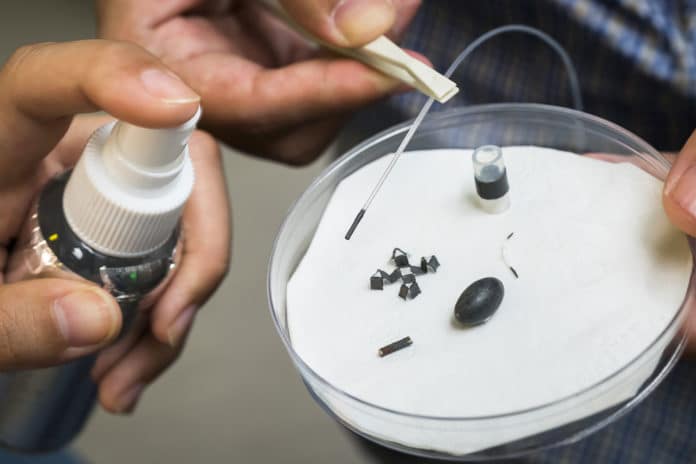Making tiny robotic devices requires miniature electronics, which makes manufacturing such mechanisms difficult and costly. Now, a group of researchers led by scientists from the City University of Hong Kong (CityU) has developed a simple way to create millirobots by coating objects with a glue-like magnetic spray, called M-spray.
Coated objects can crawl, walk, or roll on different surfaces when driven by a magnetic field. Because the magnetic coating is biocompatible and can be disintegrated into powders when needed, this technology demonstrates the potential for biomedical applications, including catheter navigation and drug delivery.
The M-spray is composed of polyvinyl alcohol (PVA), gluten, and iron particles. It instantly adheres to the rough and smooth surfaces of one (1D), two (2D), or three-dimensional (3D) objects, regardless of their structure and size, after which a film with a thickness of 0.1 to 0.25 mm is formed on the surface.

After coating with the spray, the object is magnetized with single or multiple magnetization directions, which could control how the object is moved by a magnetic field. Then the researchers applied heat on the object until the coating was solidified. After completing the procedure, the researchers receive the so-called millibots with different locomotion modes, such as crawling, flipping, walking, and rolling, on various surfaces from glass, skin, wood to sand.
The research is the result of the cooperation between the University of Hong Kong City and the Shenzhen Institute of Advanced Technology, and the Chinese Academy of Sciences. “Our idea is that by putting on this ‘magnetic coat,’ we can turn any objects into a robot and control their locomotion. The M-spray we developed can stick on the targeted object and ‘activate’ the object when driven by a magnetic field,” explained Dr. Shen Yajing, Associate Professor at CityU.
Any robot can be reprogrammed to get a different locomotion mode. During the experiment, it was possible to deliver a capsule with medicine inside the body of a sleeping rabbit. So far, the protective coating of the robot can withstand a strongly acidic environment (pH level 1) for no more than eight minutes, but replacing the iron particles with nickel particles could allow it to hold out in an acidic environment for up to half an hour.
The researchers believe their robots will be useful for transporting drugs to specific parts of the body, as moving sensors, and in many other areas.
